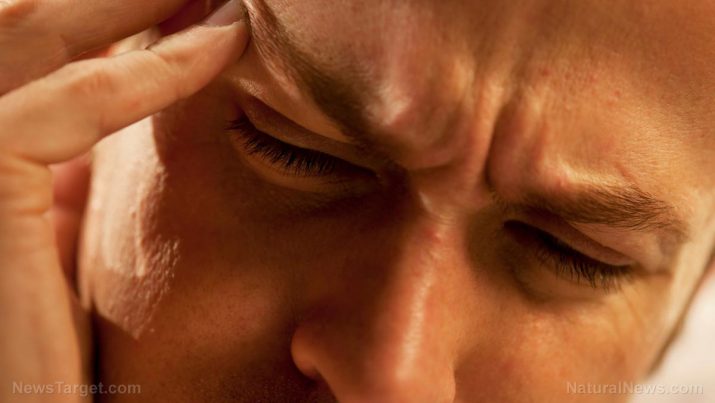
Headache – causes, side effects and treatments at NaturalPedia.com
Friday, April 20, 2018 by Ralph Flores
http://www.naturalpedia.com/headache-causes-side-effects-and-treatments-at-naturalpedia-com.html

Headaches, strictly speaking, refer to a pain felt in the head. The pain could be described either throbbing, squeezing, constant, unrelenting, or intermittent. Headaches could be isolated in one part of the face or skull, or it could be felt in the whole head.
The causes of headaches vary: It may arise spontaneously, or it may be related to an activity or exercise. It could either be an acute onset or a chronic condition, and its severity may either be progressive or constant.
There are five types of headaches. These include the following:
- Tension headaches are the most common type of headaches. These feel like a constant ache or pressure around the head, in particular, around the temples or at the back of the head. This type of headache does not cause nausea or vomiting, and it does not impede a person’s quality of life. According to experts, tension headaches could be caused by a contraction of the neck and scalp muscles in response to stress, as well as any change in brain chemicals.
- Cluster headaches, on the other hand, are recurring headaches that happen in groups at a time. A person who has the condition feels debilitating pain at its onset, usually occurring on one side of the head. A watery eye – even nasal congestion on the area that experiences the condition – may also accompany these.
- Sinus headaches occur when the sinuses become inflamed, usually because of an infection. In most cases, it also brings with it fever, as well as the presence of pus in the area.
- Rebound headaches happen when a person uses too many painkillers for headaches. Common causes include aspirin, acetaminophen, or ibuprofen, as well as prescription drugs. Some believe that this occurs because the excess medication causes the brain to shift into an excited state, producing more headaches. Others say that this could be what is called as a “withdrawal symptom” as the levels of medicine drop in the bloodstream.
- Migraine headaches, or migraines, could be passed down from generation to generation. For a headache to be called a migraine, it should:
- Have at least five previous episodes of headaches
- Last between four to 72 hours
- Be either one of these four symptoms: one-sided pain, throbbing pain, moderate-to-severe pain, and pain that impairs with (or is worsened by) or completely inhibits an activity
- Have at least one of these associated features – nausea, vomiting, or, sensitivity to light and sound

Known risk factors and symptoms of headaches
Headaches occur when the pain-sensing structures of the head experience irritation or injury. These include the scalp, forehead, top of the head, the muscles of the neck and head, major arteries and veins in the head, the sinuses, and the tissues that surround the brain. It may also occur when these experience compression, spasm, tension, inflammation, or irritation.
While the etiology of a headache is unclear, specific events trigger mild headaches. These include:
- Stress
- Hormonal changes before, during, or after menstruation
- Muscle tension
- Exhaustion
- Hunger and dehydration
- Medications
- Withdrawal from alcohol, caffeine, and sugar
However, there are cases where headaches are indicative of something worse. Carbon monoxide poisoning, for example, can bring recurring headaches to all persons in the area. When pain in the eyes and vomiting accompanies the headaches, it could be a sign of an eye disease called glaucoma which needs medical attention.
Headaches, when it occurs with neck stiffness or pain, light sensitivity, fever, and confusion, could be a symptom of meningitis, or the inflammation of the surrounding membrane in the brain.
Body systems affected by headaches
The pain experienced during a headache primarily affects the head; however, depending on its severity, it could affect a person’s daily routine.
Food items or nutrients that may prevent or relieve headaches
Certain food items can help relieve headaches or even prevent it altogether. Here are some recommended food items to help with a headache.
- Potatoes contain electrolytes like potassium to manage headaches due to dehydration.
- Cucumbers are 97 percent water, which can help you hydrate and manage headaches.
- Cherries convert compounds to nitric oxide in the blood, which helps protect against tension headaches and migraine.
- Hot peppers can relieve sinus headaches by decreasing the pressure in the sinuses and clearing congestion.
- Pumpkin seeds contain magnesium which relaxes blood vessels and help manage headaches.
Treatment and management options for headaches
Most headaches go away on their own if it’s not indicative of something serious. When you have a headache, the following measures may prove helpful:
- Drink a lot of water
- Get plenty of rest (especially if a headache is because of a cold or the flu)
- Avoid stress
- Exercise when you can
It’s not a good idea to down a headache with alcohol as it makes it worse.
Where to learn more
- Eco-friendly LED light bulbs found to cause increase in headaches
- Relieving Headache Pain Naturally
- Headache Relief Without Drugs: 8 Natural Remedies
- Got a headache? Foods and the active components within them that will alleviate even the toughest headaches fast
Summary
Headaches refer to a pain felt in the head. Its causes of headaches vary: It may either arise spontaneously, be related to an activity or exercise, or even be an acute onset or a chronic condition.
Headaches occur when the pain-sensing structures of the head experience irritation or injury or experience compression, spasm, tension, inflammation, or irritation.
The pain experienced during a headache primarily affects the head; however, depending on its severity, it could affect a person’s daily routine.
Sources include:
Tagged Under: Tags: headaches





